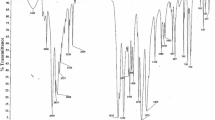Abstract
In the crystal structures of (2,6-lutidinium)2[CuCl4], 1 and (2,6-lutidinium)2[CuBr4], 2, the anion CuX4 2− is connected to eight and four surrounding cations in 1 and 2, respectively, through (N–H···X) (H2C–H···X) and (C–H···X) hydrogen bonds to form two-dimensional layers approximately normal to the crystallographic b-axis. These layers are further connected by means of offset face-to-face interactions (parallel to b-axis) to give three-dimensional structures. The hydrogen bonding (type and number) around each anion could be influenced by the anion size, as same cation is used, allowing different cation…anion interpenetrations.
Graphical abstract
Three dimensional framework structures of tetrahalocuprate(II) complexes assembled via (N–H···X), (H2C–H···X) and (C–H···X) hydrogen bonds along with π···π stacking and X···π interactions.





Similar content being viewed by others
References
Desiraju GR (1997) Chem Commun 1475
Hunter CA (1994) Chem Soc Rev 2:101
Desiraju GR, Steiner T (1999) The weak hydrogen bond in structural chemistry and biology. Oxford University Press, Oxford
Allen FH, Hoy VJ, Howard JAK, Thalladi VR, Desiraju GR, Wilson CC, McIntyre GJ (1997) J Am Chem Soc 119:3477
Dolling B, Gillon AL, Orpen AG (2001) Chem Commun 567
Panunto TW, Urbanczyk-Lipkowska Z, Johnson R, Etter MC (1987) J Am Chem Soc 109:7786
Robinson JMA, Philp D, Harris KDM, Kariuki BM (2000) New J Chem 24:799
Luque A, Sertucha J, Castillo O, Román PJ (2001) New J Chem 25:1208
Luque A, Sertucha J, Lezama L, Rojo T, Román PJ (1997) Chem Soc Dalton Trans 847
Aakeröy CB, Beatty AM, Leinen DS, Lorimer KR (2000) Chem Commun 935
Willett RD, Haddad SF, Middleton M (2000) Acta Cryst C56:437
Willett RD, Place H, Twamley B (1988) J Am Chem Soc 110:8639
Severns JC, Bunting RK, West DX (1986) Inorg Chim Acta 115:3
Prince BJ, Turnbull MM, Willett RD (2003) J Coord Chem 56:441
Desiraju GR (2002) Acc Chem Res 35:565
Steiner T (2002) Angew Chem Int Ed 41:48
Liberman HF, Davey RJ, Newsham DMT (2000) Chem Matter 12:490
Dance IG (2003) New J Chem 27:22
Willett RD, Awwadi F, Butcher R, Haddad SF, Twamley B (2003) Cryst Growth Des 3:301
Dance IG (1996) In: Desiraju GR (ed) The crystal as a supramolecular entity. Wiley, New York, pp 137–233
Nangia A, Desiraju GR (1998) Topics in current chemistry. Springer, Berlin
Nishio M, Hirota M, Umezawa Y (1998) The CH/pi interaction (evidence, nature and consequences). Wiley-VCH, New York
Al-Far R, Ali BF (2008) J Chem Cryst 38:373
Al-Far R, Ali BF (2007) J Chem Cryst 37:333
Al-Far R, Ali BF, Al-Sou’oud K (2006) J Chem Cryst 36:523
Bruker XSCANS (1996) Siemens analytical X-ray instrument (version 2.20). Bruker AXS Inc, Madison, WI
Sheldrick GM (2002) SHELXTL (version 6.14), structure determination software suite. Bruker AXS Inc, Madison, WI
Haddad SF, AlDaamen MA, Willett RD (2006) Inorg Chim Acta 359:424
Raithby PR, Shields GP, Allen FH, Samuel Motherwell WD (2000) Acta Cryst B56:444
Sunberg MR, Kivekäs R, Ruiz J, Moreno JM, Colacio E (1992) Inorg Chem 31:1062
Reinen D, Atanasov M, Nicolov GS, Steffens F (1988) Inorg Chem 27:1678
Bond AD, Davies JE, Kirby AJ (2001) Acta Cryst E57:o1242
Acknowledgements
Al al-Bayt University, Al-Balqa Applied University and The University of Jordan are thanked for financial support.
Author information
Authors and Affiliations
Corresponding author
Rights and permissions
About this article
Cite this article
Ali, B.F., Al-Far, R. & Haddad, S.F. Hydrogen Bonded, π···π Stacked and X···π Framework Structures in Bis(2,6-Lutidinium) Tetrahalocuprate(II) Complexes. J Chem Crystallogr 40, 696–701 (2010). https://doi.org/10.1007/s10870-010-9724-8
Received:
Accepted:
Published:
Issue Date:
DOI: https://doi.org/10.1007/s10870-010-9724-8




